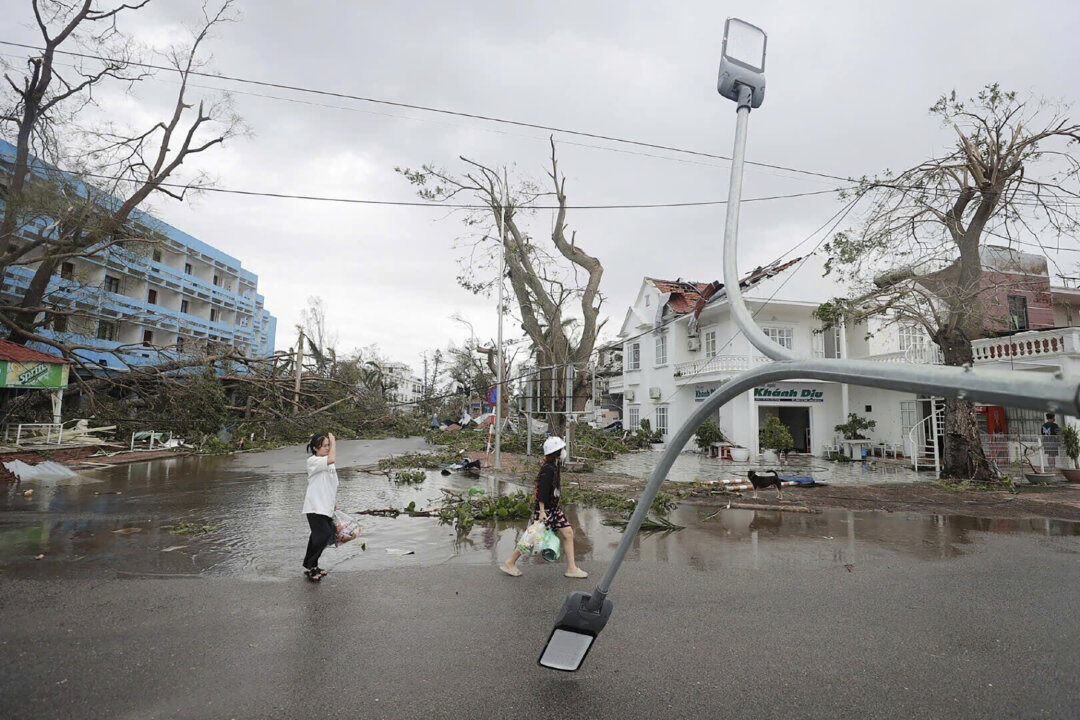Global supply chains could be affected as Vietnam hosts many textile and component plants that export to the United States, Europe, and other parts of Asia.
At least 233 people have been killed by Typhoon Yagi, which has devastated northern Vietnam and damaged dozens of factories, potentially affecting global supply chains.
Hanoi-based newspaper VNExpress reported that 233 people were confirmed dead and 103 were still missing on Sept. 12, while more than 800 were injured.
Yagi, which has left more than 3 million people without electricity, has been described by Vietnamese officials as one of the most powerful storms to hit the region in the past decade.
The storm made landfall in Vietnam’s northern coastal provinces of Quang Ninh and Haiphong on Sept. 7 and ripped up the north of the country for 15 hours before gradually weakening on the morning of Sept. 8.
Entire Village Swept Away
The initial death toll was given as 14, but the number rose significantly after reports of a flash flood sweeping away an entire village, Lang Nu, in Lao Cai Province.
Hundreds of rescue personnel worked through Sept. 11 looking for survivors in Lang Nu. Forty-two bodies were found and 53 villagers remained missing as of the morning of Sept. 12, VNExpress reported.
Northern Vietnam has a heavily export-oriented economy and Typhoon Yagi has caused severe damage to many factories and warehouses that supply some of the world’s biggest corporations.
Some plants could remain shuttered for several weeks.
“Many of them are gone with the wind,” said Calvin Nguyen, head of Vietnamese logistics company WeDo Forwarding Co., referring to products that were being warehoused, awaiting export.
Bruno Jaspaert, CEO of DEEP C industrial zones, said many factories in Haiphong and the neighboring province of Quang Ninh still lacked electricity and water.
He said 20 out of 150 plants would be out of action for weeks.
The factory of Chinese solar panel maker Jinko Solar has been severely damaged, with windows smashed and the roof blown off.
Samsung and Apple Suppliers
Inland, the industrial hubs of Thai Nguyen and Bac Giang, which are home to factories belonging to international companies such as Apple supplier Foxconn, may have also been affected.
Samsung Electronics’ biggest plant, in Thai Nguyen, 37 miles north of Hanoi, appears to have escaped major damage, with water receding.
Samsung’s three warehouses in Haiphong had their roofs blown off and were flooded, causing millions of dollars worth of damage.
In the northern coastal city of Haiphong, 95 percent of businesses were expected to resume some kind of work by Sept. 17, according to the body managing its industrial zones.
“Many businesses had their roofs blown off, some walls collapsed, gates, fences, signs, camera systems, garages and sliding metal doors were overturned, water flooded into factories,” the managing body said.
Jupiter Logistics, which is part of a group co-owned by Japan Airlines, is understood to have been one of the affected companies.
South Korea’s LG Electronics, which also has facilities in Haiphong, said it had partly resumed work after a factory wall was blown down on Sept. 7, leading to flooding in a warehouse stocked with refrigerators and washing machines.
State-owned power company EVN is working to repair damaged electricity lines, but several northern provinces remain badly affected by power cuts.
Vietnam’s industry ministry has not commented on the effects of Typhoon Yagi on the country’s economy.
Typhoons are low-pressure circular storms that form in the oceans of the Intertropical Convergence Zone. They typically develop in the Northwest Pacific between June and October.
Typhoons are similar to hurricanes, which develop over the North Atlantic, and cyclones, which develop in the South Pacific and Indian Ocean.
According to the Borgen Project, the deadliest typhoon in history killed around 300,000 people in Haiphong, Vietnam, in 1881.
The Associated Press and Reuters contributed to this report.

